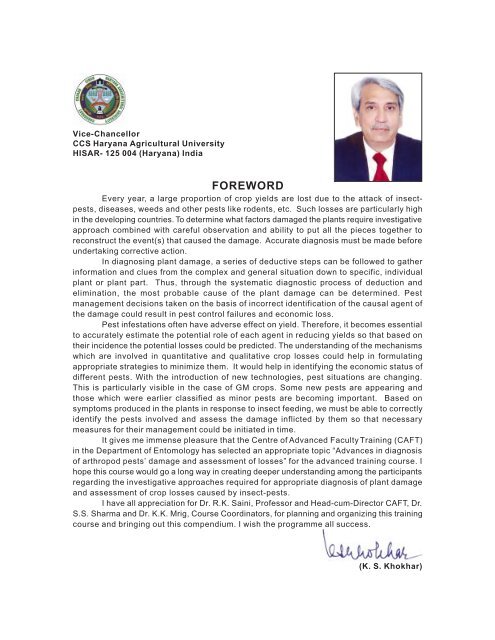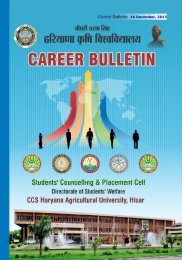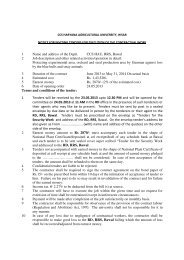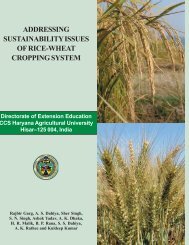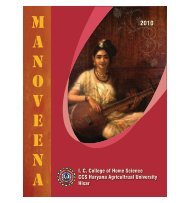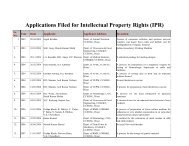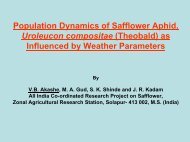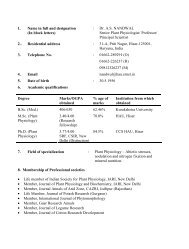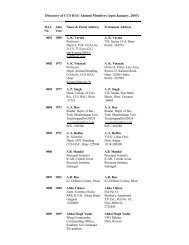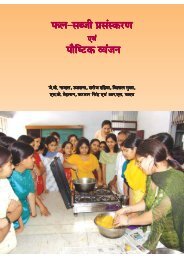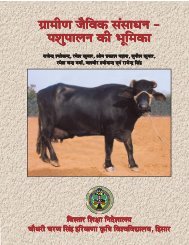Foreword - CCS HAU, Hisar
Foreword - CCS HAU, Hisar
Foreword - CCS HAU, Hisar
You also want an ePaper? Increase the reach of your titles
YUMPU automatically turns print PDFs into web optimized ePapers that Google loves.
Vice-Chancellor<br />
<strong>CCS</strong> Haryana Agricultural University<br />
HISAR- 125 004 (Haryana) India<br />
FOREWORD<br />
Every year, a large proportion of crop yields are lost due to the attack of insectpests,<br />
diseases, weeds and other pests like rodents, etc. Such losses are particularly high<br />
in the developing countries. To determine what factors damaged the plants require investigative<br />
approach combined with careful observation and ability to put all the pieces together to<br />
reconstruct the event(s) that caused the damage. Accurate diagnosis must be made before<br />
undertaking corrective action.<br />
In diagnosing plant damage, a series of deductive steps can be followed to gather<br />
information and clues from the complex and general situation down to specific, individual<br />
plant or plant part. Thus, through the systematic diagnostic process of deduction and<br />
elimination, the most probable cause of the plant damage can be determined. Pest<br />
management decisions taken on the basis of incorrect identification of the causal agent of<br />
the damage could result in pest control failures and economic loss.<br />
Pest infestations often have adverse effect on yield. Therefore, it becomes essential<br />
to accurately estimate the potential role of each agent in reducing yields so that based on<br />
their incidence the potential losses could be predicted. The understanding of the mechanisms<br />
which are involved in quantitative and qualitative crop losses could help in formulating<br />
appropriate strategies to minimize them. It would help in identifying the economic status of<br />
different pests. With the introduction of new technologies, pest situations are changing.<br />
This is particularly visible in the case of GM crops. Some new pests are appearing and<br />
those which were earlier classified as minor pests are becoming important. Based on<br />
symptoms produced in the plants in response to insect feeding, we must be able to correctly<br />
identify the pests involved and assess the damage inflicted by them so that necessary<br />
measures for their management could be initiated in time.<br />
It gives me immense pleasure that the Centre of Advanced Faculty Training (CAFT)<br />
in the Department of Entomology has selected an appropriate topic “Advances in diagnosis<br />
of arthropod pests’ damage and assessment of losses” for the advanced training course. I<br />
hope this course would go a long way in creating deeper understanding among the participants<br />
regarding the investigative approaches required for appropriate diagnosis of plant damage<br />
and assessment of crop losses caused by insect-pests.<br />
I have all appreciation for Dr. R.K. Saini, Professor and Head-cum-Director CAFT, Dr.<br />
S.S. Sharma and Dr. K.K. Mrig, Course Coordinators, for planning and organizing this training<br />
course and bringing out this compendium. I wish the programme all success.<br />
(K. S. Khokhar)


